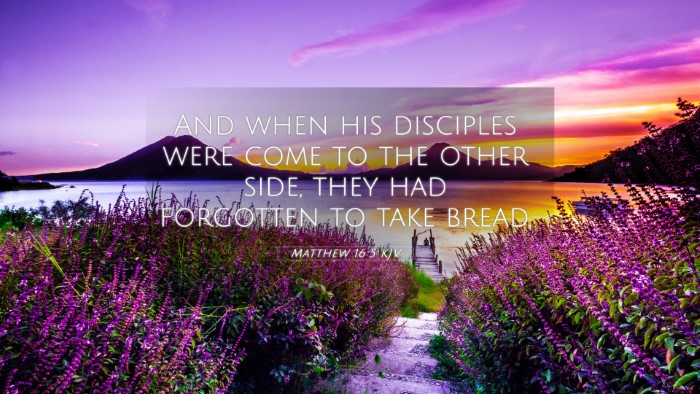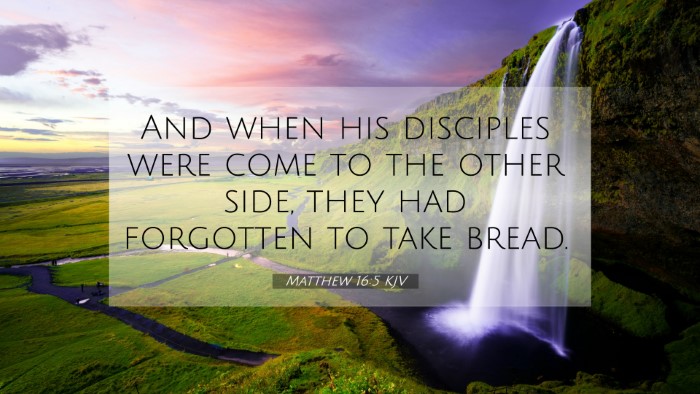Understanding Matthew 16:5
Matthew 16:5 states, "And when his disciples were come to the other side, they had forgotten to take bread." This moment captures a situation that highlights not only the human tendency to forget but also serves as a deeper lesson for spiritual awareness and dependence on divine provision.
Commentary Insights
This verse prompts various reflections from well-regarded public domain commentaries. Matthew Henry notes the disciples’ forgetfulness as an illustration of how easily we can shift our focus from the miraculous and spiritual to the mundane aspects of life, especially when entrapped by physical concerns.
Albert Barnes emphasizes the importance of understanding the context, suggesting that the disciples had just witnessed Jesus perform miracles, yet they were preoccupied with their needs. This indicates a disconnect between faith and daily existence, urging believers to maintain a spiritual focus even amid earthly concerns.
Adam Clarke adds another layer by examining the symbolism of “bread.” In biblical context, bread often denotes sustenance, not just physical but also spiritual. Therefore, Clarke suggests that this verse serves as a reminder that Jesus, as the Bread of Life, provides everything necessary for both physical and spiritual nourishment.
Spiritual Lessons
The key lessons drawn from this verse include:
- Human Fragility: Our propensity to forget God’s provision and past miracles, especially when faced with new challenges.
- Need for Focus: Believers must focus on Christ and His teachings rather than letting daily concerns distract them from their faith.
- Symbolism of Bread: Recognizing that physical needs can symbolize deeper spiritual neglect.
Cross-References
Matthew 16:5 can be enlighteningly linked with several other Bible texts through cross-references that highlight similar themes:
- John 6:35: Jesus declares Himself to be the Bread of Life.
- Luke 9:13-17: The feeding of the five thousand, showing God's provision.
- Mark 8:14-21: Discusses the leaven of the Pharisees and a warning about spiritual blindness.
- Exodus 16:4: God providing manna in the wilderness as a metaphorical foreshadowing of Christ’s sustenance.
- Philippians 4:19: Assurance that God will supply all our needs.
- Matthew 14:19: Jesus giving thanks for bread before breaking it.
- 1 Corinthians 10:3: Reference to spiritual food in the wilderness, providing a parallel to the physical hunger faced by the disciples.
- Psalm 78:24: Mention of God raining down food from heaven, reinforcing divine provision.
- Hebrews 13:5: Encouragement to remember that God will never leave us nor forsake us, paralleling with our daily worries.
- Matthew 6:25-34: Jesus instructs about not worrying over food and drink, emphasizing faith in God’s provision.
Concluding Thoughts
In studying Matthew 16:5, we gain a critical insight into maintaining a focus on Christ amidst life's distractions. This verse encourages believers to lean on their faith and remain cognizant of God's continual provision. Cross-references serve as vital tools for a deeper understanding, demonstrating how scriptural texts interconnect and enrich our overall comprehension of Biblical truths.
Tools and Methods for Cross-Referencing
For those interested in exploring more about how to navigate these connections, consider using:
- Bible Concordance: An essential resource for finding specific terms and their occurrences in scripture.
- Bible Cross-Reference Guide: A tool that provides related verses and themes stemming from one verse.
- Bible Reference Resources: Various commentaries and study guides can provide deeper insights into scripture.
- Cross-Referencing Bible Study Methods: Strategies such as thematic studies that explore how different verses relate across both Testaments.
- Comprehensive Bible Cross-Reference Materials: Look for Bible software or applications that feature interlinked verses for a more robust study experience.
Through this comprehensive analysis of Matthew 16:5, we uncover profound truths about faith, spiritual awareness, and the relationships between various scriptures that enrich our understanding and worship.




